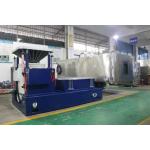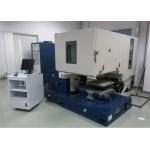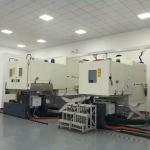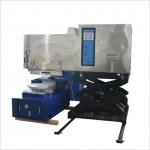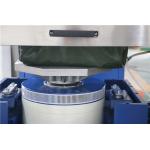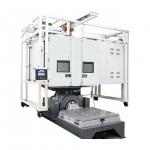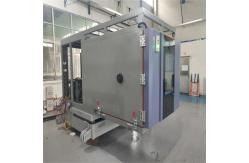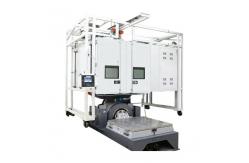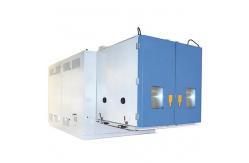In the highly competitive automotive industry, the reliability and
durability of automotive components are non-negotiable. The
Environment Test Chamber, which combines vibration, temperature,
and humidity testing capabilities, emerges as a crucial tool for
evaluating the performance of automotive components under a wide
spectrum of real-world conditions. This advanced testing chamber is specifically designed to subject
automotive components to simultaneous vibration, temperature, and
humidity stresses. It caters to automotive manufacturers, Tier-1
suppliers, and research institutions. The primary objective is to
assess how well these components can withstand the complex and
often harsh environmental and mechanical forces they encounter
during a vehicle's operation. By replicating these conditions in a
controlled laboratory setting, manufacturers can identify potential
weaknesses, optimize component designs, and ensure compliance with
industry standards and regulations. Robust and Insulated Chamber Construction The test chamber is built with a heavy-duty steel frame that
provides exceptional rigidity and stability. The frame is coated
with a corrosion-resistant finish to ensure long-term durability.
The chamber walls are made of high-quality insulation materials
that minimize heat transfer and maintain precise temperature and
humidity levels. The insulation is designed to withstand the rigors
of continuous testing and prevent any external factors from
interfering with the internal test environment. The chamber is also
equipped with a double-door system, with an inner door made of
transparent polycarbonate for easy visual inspection during tests
and an outer insulated door for enhanced sealing.
Precision Vibration System The vibration system integrated into the chamber is a marvel of
engineering. It can generate a wide range of vibration frequencies
and amplitudes. The frequency range can span from as low as 5 Hz,
simulating the low-frequency vibrations from engine idling and road
undulations, to as high as 2000 Hz, replicating the high-frequency
vibrations from components like turbochargers and transmission
gears. The vibration amplitude can be adjusted with great accuracy,
from a few micrometers to several centimeters. The vibration table
is made of a high-strength alloy and is dynamically balanced to
ensure uniform and stable vibration transmission. It is controlled
by a sophisticated computerized control unit that allows for the
creation of complex vibration profiles, including random
vibrations, sine waves, and shock pulses.
Advanced Temperature and Humidity Control Mechanism The chamber features a state-of-the-art temperature and humidity
control system. It can accurately maintain a wide temperature
range, from -40°C to +150°C. The temperature
control is achieved through a combination of high-efficiency
refrigeration units, electric heaters, and precise temperature
sensors. The humidity control range extends from 10% to 95%
relative humidity. This is accomplished using humidifiers and
dehumidifiers, along with humidity sensors that provide real-time
feedback. The control system continuously monitors and adjusts the
temperature and humidity levels to ensure they remain within the
set parameters, even during long and demanding test sequences.
Intuitive Control Panel and Data Acquisition System The chamber is equipped with a user-friendly control panel that
simplifies the testing process. The panel has a large touchscreen
display that allows operators to easily input test parameters,
select pre-programmed test profiles, and monitor the progress of
the test in real-time. It provides clear visual feedback on the
current temperature, humidity, vibration frequency, and amplitude.
The data acquisition system records all relevant test data,
including temperature and humidity fluctuations, vibration
patterns, and any anomalies or failures that occur during the test.
The data can be stored in a built-in memory or exported to external
storage devices for further analysis. The system also has the
ability to generate detailed test reports in various formats, such
as PDF or Excel.
Safety Features and Alarms To ensure the safety of operators and the integrity of the testing
process, the chamber is equipped with a comprehensive set of safety
features. It has multiple emergency stop buttons strategically
located around the chamber for immediate shutdown in case of any
abnormal situation. The chamber is also equipped with
over-temperature, over-humidity, and over-vibration alarms. These
alarms will sound and trigger an automatic shutdown if the set
safety limits are exceeded. The chamber's internal wiring and
components are designed to meet the highest safety standards, with
proper grounding and insulation to prevent any electrical hazards.
Maximum Vibration Displacement The chamber can achieve a maximum vibration displacement of
±50 mm. This significant displacement capacity allows
for the simulation of extreme vibration conditions, such as those
experienced during off-road driving or high-impact collisions. For
example, when testing the durability of a vehicle's suspension
components, a large vibration displacement can help uncover
potential weaknesses in the design or material.
Vibration Frequency Range As mentioned, the vibration frequency range is from 5 Hz to 2000
Hz. This broad range covers the entire spectrum of vibrations that
automotive components may encounter. Low-frequency vibrations can
affect the stability and alignment of larger components, while
high-frequency vibrations can cause fatigue and failure in smaller,
more delicate parts. Testing across this frequency range ensures a
comprehensive evaluation of component performance.
Temperature Control Range The chamber's temperature control range of -40°C to
+150°C is essential for replicating the wide variety of
temperature conditions that automotive components face. From the
freezing cold of winter in polar regions to the scorching heat of
deserts, components must function reliably. For instance,
electronic components in the engine bay need to withstand high
temperatures, while exterior parts like door handles and mirrors
must endure freezing temperatures without cracking or
malfunctioning.
Humidity Control Range The humidity control range from 10% to 95% relative humidity is
crucial as moisture can have a significant impact on component
performance. High humidity levels can cause corrosion of metal
parts and affect the electrical conductivity of connectors. Low
humidity can lead to static electricity buildup, which may damage
sensitive electronic components. Testing at different humidity
levels helps manufacturers understand how their components will
behave in various climatic conditions.
Maximum Payload Capacity The chamber has a maximum payload capacity of up to 1000 kg. This
generous capacity allows for the testing of a wide range of
automotive components, from small sensors and relays to larger
assemblies like engine blocks and transmissions. It enables
manufacturers to test multiple components or complete systems
simultaneously, increasing testing efficiency and providing a more
comprehensive assessment of overall system performance.
Comprehensive Component Durability Evaluation The primary function of the test chamber is to provide a detailed
and accurate assessment of automotive component durability. By
subjecting components to simultaneous vibration, temperature, and
humidity stresses, it determines how well they can endure the
combined effects of these factors. This information is invaluable
for manufacturers to identify potential failure points and make
design improvements. For example, a manufacturer of automotive
electronics can use the chamber to evaluate the performance of a
circuit board under different temperature and humidity conditions
while being subjected to vibrations, and then take corrective
actions to enhance its reliability.
Design Optimization and Innovation Through a series of tests on different component prototypes,
manufacturers can utilize the data obtained from the chamber to
optimize their designs. They can analyze the performance of various
materials, component geometries, and manufacturing processes. For
instance, a supplier of automotive braking systems can study the
effect of using different types of brake pad materials and rotor
designs under extreme temperature and vibration conditions. By
making data-driven design decisions, they can create more efficient
and durable components that offer better performance and safety.
Quality Control and Compliance Assurance The chamber is an essential tool for quality control in the
automotive industry. It allows companies to ensure that each batch
of components meets the required durability and performance
standards. It can also be used to conduct compliance testing to
meet industry regulations and customer specifications. For example,
a vehicle manufacturer may require that all components used in
their vehicles pass a specific set of vibration, temperature, and
humidity tests. The chamber provides the necessary data to prove
compliance, ensuring that only high-quality components are used in
the final product.
Research and Development Support In the field of automotive research and development, the chamber
offers valuable insights. Researchers can use it to study the
fundamental behavior of components under complex environmental and
mechanical stresses. They can explore new materials and
technologies aimed at improving component performance. For example,
a research team may use the chamber to test the potential of a new
type of lightweight alloy for use in automotive chassis components
and analyze its durability and strength under different conditions.
|
